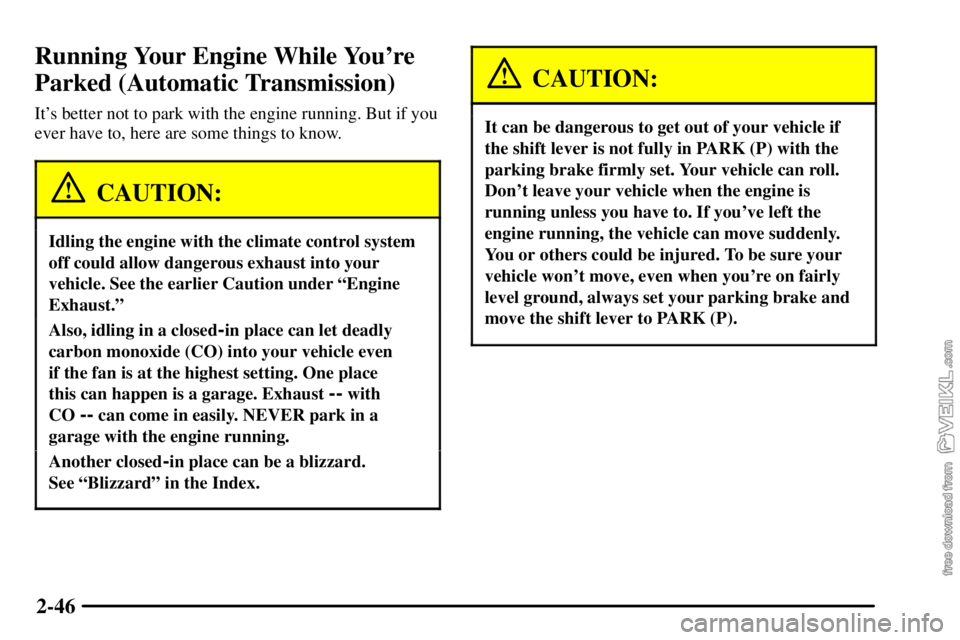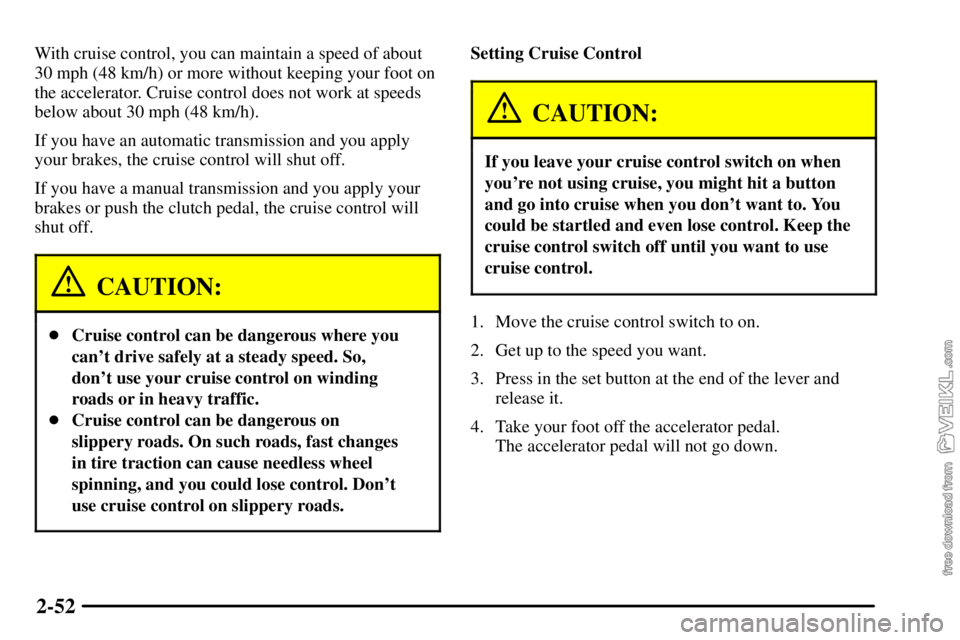Page 106 of 386

2-31
The accelerator and clutch pedals must be released in
order for the exhaust brake to engage. The exhaust brake
will not function when the cruise control feature is
active, and will automatically shut off when the
anti
-lock brake system is active.
CAUTION:
Be careful when using the exhaust brake or you
could lock the wheels and lose control of the
vehicle. Operators not familiar with an exhaust
brake should not use this brake on slippery
surfaces before learning to use it on dry surfaces.
If the vehicle's wheels begin to lock when using
the exhaust brake on slippery surfaces, switch the
exhaust brake off immediately. The exhaust
brake will turn off if the anti
-lock brake system
is activated.
Tw o-Speed Rear Axle Electric Shift
Control (If Equipped)
If your vehicle is equipped with this feature, you'll find
a label on the headliner above the windshield or in
another place near the driver that shows how to use it.
Be sure to follow the directions carefully.
Use the following directions based on the type of shift
control you have.
Manual Transmission
The rear axle shift control
switch for a manual
transmission is located
on the shift lever.
When the switch is up, the rear axle is in the high range.
Push the switch down to change to low range.
Page 107 of 386

2-32
The two-speed axle should be in low when you park the
vehicle. You'll need to engage the transmission, even
move the vehicle a little, to be sure the axle is in the low
range. Then apply the parking brake, shift into
NEUTRAL and shut off the engine.
Also, always start the vehicle in motion with the
two
-speed axle in the low range. To shift up from low to
high, do the following:
1. Move the switch up for the high range,
2. disengage the clutch, and
3. after a brief pause, engage the clutch and then press
down on the accelerator.
To shift down from high to low, do the following:
1. Move the switch down to low,
2. release the accelerator and then quickly apply
it again.
Automatic Transmission
The rear axle shift control
switch for an automatic
transmission is located in
the instrument panel
switchbank.
Press the bottom of the switch to get to the low range.
The switch indicator light will come on when the
vehicle is in low range. Press the top of the switch to
return to the high range.
The two
-speed axle should be in low range when you
park the vehicle. Apply the parking brake, shift to
PARK (P) or NEUTRAL (N) and shut off the engine.
To operate off
-road or under a heavy load, shift into low
range when the vehicle is standing still and then operate
the transmission normally.
Page 108 of 386

2-33
On the highway, with the axle in low range and the
transmission in top gear, you may shift the axle to high
range by raising the switch and releasing the accelerator
momentarily. Reapply the accelerator after you shift.
Under light load conditions, first shift the axle into the
high range with the vehicle at a standstill and then
operate the transmission normally.
Air Shift Control (Automatic Transmission)
The switch for the rear axle
shift control is located in the
instrument panel
switchbank.
Press the bottom of the switch to get to the low range.
Press the top of the switch to return to the high range.The two
-speed axle should be in low when you park
the vehicle.
You'll need to engage the transmission, even moving the
vehicle a little, to be sure the axle is in low range. Then
shift into PARK (P), apply the parking brake and shut
off the engine.
Also, always start the vehicle in motion with the
two
-speed axle in the low position. To shift up from
low to high, press the top of the rear axle shift control
switch and press down on the accelerator. When you
shift the axle from high to low, press the bottom of the
switch, release the accelerator and then quickly press it
down again.
Air Suspension (If Equipped)
Your vehicle may be equipped with the Hendrickson
HAS Series single
-axle air suspension which is designed
for single
-axle on-highway use. The feature is available
in 19,000 lb. (8 618.3 kg), 21,000 lb. (9 525.4 kg) and
23,000 lb. (10 432.6 kg) capacities for operations which
require extra cubic capacity and a reduced deck height.
Page 109 of 386

2-34 Rear Air Suspension Dump Control
If your vehicle is equipped with the Hendrickson HAS
Series single
-axle air suspension, you have this control.
The air suspension dump control allows the operator to
lower the deck height approximately 4.5 inches
(11.5 cm) from the normal frame height.
The switch to deflate and
inflate the air suspension is
located in the instrument
panel switchbank.
Press the bottom of the switch to deflate the air
suspension and lower the deck height. Press the top
of the switch to return the suspension to normal
deck height.
An indicator light will come on and stay on whenever
the switch is in the dumped position.
Automatic Transmission Operation
We build vehicles with five and six-speed automatic
transmissions. This part of the manual covers the basics
of these. With some of the transmissions, you will find
another manual in your vehicle that goes into more
detail. On the headliner, in front of and above the driver,
or in some other place near the driver, you will see a
label that describes important operating facts about the
automatic transmission in your vehicle. Make sure you
follow the instructions on this label.
Be sure to keep your parking brake set until you are
ready to shift into DRIVE (D), and press the brake pedal
while shifting from NEUTRAL (N) or PARK (P) to a
drive gear.
All vehicles equipped with automatic transmissions
can be started in PARK (P), if equipped, or in
NEUTRAL (N). See the Allison
� Transmission
Operator's Manual in your vehicle for more information
about this.
Page 112 of 386

2-37 Eaton Fuller Five and Six-Speed
Transmissions and TTC Spicer
Seven-Speed Transmissions
These transmissions have gears that automatically
synchronize when you shift up or down (except
FIRST (1) gear on the five
-speed and seven-speed
transmission which is unsynchronized). Choose the gear
that will maintain the road speed you want while
keeping the engine above two
-thirds of the governed
speed. When the engine speed drops below two
-thirds of
the governed speed, shift into the next lower gear before
your engine begins to lug. When you shift down, be sure
to double
-clutch if required.
ZF Six-Speed Transmission
Here's how to operate
your transmission.
This six
-speed pattern is unique to GM manual
transmissions. The transmission always repositions
the shift lever to neutral, which is located between
FOURTH (4) and FIFTH (5) gear.
To prevent unintentional gear selections, additional
force is required to move the shift lever into
REVERSE (R) or FIRST (1). Use FIRST (1) when
trailer towing, driving with payload in the pickup box or
launching on a grade. Otherwise, start in SECOND (2)
gear. Only shift into FIRST (1) when the vehicle has
stopped moving.
Page 119 of 386

2-44
CAUTION:
If you apply any one of the air brake parking
controls while the vehicle is moving, your rig will
stop suddenly. If you are not ready for this, you
or others could be injured. Don't apply any one
of these controls while you're driving, unless you
have to make an emergency stop.
If the air pressure drops below 60 to 70 psi (413 to
482 kPa), the primary brake light and warning buzzer
will come on. If the air pressure drops to 35 to 45 psi
(241 to 310 kPa), the red trailer air supply knob will
automatically pop out and apply the spring brakes on
the trailer.If the air pressure drops to 35 to 45 psi (241 to 310 kPa),
the yellow park brake knob will automatically pop out
and apply the spring brakes on the truck or tractor.
If you ever have a complete loss of air so that your air
brakes automatically apply, there is a way that the tow
operator can release the parking brakes to tow the
vehicle. See ªTowing Your Vehicleº in the Index.
CAUTION:
If your vehicle is left in gear, the engine can start
if the vehicle starts to roll. This can easily happen
if you have the diesel engine. Shift the
transmission into NEUTRAL (N) before you
leave the vehicle.
Page 121 of 386

2-46
Running Your Engine While You're
Parked (Automatic Transmission)
It's better not to park with the engine running. But if you
ever have to, here are some things to know.
CAUTION:
Idling the engine with the climate control system
off could allow dangerous exhaust into your
vehicle. See the earlier Caution under ªEngine
Exhaust.º
Also, idling in a closed-in place can let deadly
carbon monoxide (CO) into your vehicle even
if the fan is at the highest setting. One place
this can happen is a garage. Exhaust
-- with
CO
-- can come in easily. NEVER park in a
garage with the engine running.
Another closed-in place can be a blizzard.
See ªBlizzardº in the Index.
CAUTION:
It can be dangerous to get out of your vehicle if
the shift lever is not fully in PARK (P) with the
parking brake firmly set. Your vehicle can roll.
Don't leave your vehicle when the engine is
running unless you have to. If you've left the
engine running, the vehicle can move suddenly.
You or others could be injured. To be sure your
vehicle won't move, even when you're on fairly
level ground, always set your parking brake and
move the shift lever to PARK (P).
Page 127 of 386

2-52
With cruise control, you can maintain a speed of about
30 mph (48 km/h) or more without keeping your foot on
the accelerator. Cruise control does not work at speeds
below about 30 mph (48 km/h).
If you have an automatic transmission and you apply
your brakes, the cruise control will shut off.
If you have a manual transmission and you apply your
brakes or push the clutch pedal, the cruise control will
shut off.
CAUTION:
�Cruise control can be dangerous where you
can't drive safely at a steady speed. So,
don't use your cruise control on winding
roads or in heavy traffic.
�Cruise control can be dangerous on
slippery roads. On such roads, fast changes
in tire traction can cause needless wheel
spinning, and you could lose control. Don't
use cruise control on slippery roads.
Setting Cruise Control
CAUTION:
If you leave your cruise control switch on when
you're not using cruise, you might hit a button
and go into cruise when you don't want to. You
could be startled and even lose control. Keep the
cruise control switch off until you want to use
cruise control.
1. Move the cruise control switch to on.
2. Get up to the speed you want.
3. Press in the set button at the end of the lever and
release it.
4. Take your foot off the accelerator pedal.
The accelerator pedal will not go down.